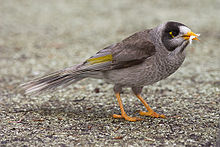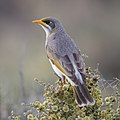| Manorina | |
|---|---|

| |
| Yellow-throated miner (Manorina flavigula) | |
|
Scientific classification
| |
| Domain: | Eukaryota |
| Kingdom: | Animalia |
| Phylum: | Chordata |
| Class: | Aves |
| Order: | Passeriformes |
| Family: | Meliphagidae |
| Genus: |
Manorina Vieillot, 1818 |
| Type species | |
|
Manorina viridis
[1] Vieillot, 1818
| |
Manorina is a genus of Australian endemic honeyeaters, containing four species: the black-eared miner (M. melanotis) the yellow-throated miner (M. flavigula), the noisy miner (M. melanocephala) and the bell miner (M. melanophrys). The genus is notable for the complex social organisation of its species, which live in colonies that can be further subdivided into coteries and nest contingents.
Description
The four species are stockily built honeyeaters with rounded wings and yellow bills. One of their most obvious characteristics is a patch of bare yellow skin behind the eyes, which gives them an odd ' cross-eyed' look. [2] They are predominantly insectivorous and feed by gleaning. Their nests sit on other structures (such as tree branches) rather than hang down. [2]
Taxonomy

The genus was first described by French naturalist Louis Pierre Vieillot in volume 19 of his work Nouveau Dictionnaire d'Histoire Naturelle, appliquée aux arts, principalement à l'Agriculture, à l'Écomomie rurale et domestique, à la Médecine, etc. Par une société de naturalistes et d'agriculteurs. Nouvelle Édition in 1818. Later it was misspelt as Manorhina, but is now spelt in its original manner. [3]
Richard Schodde felt the genus was related to the black-headed honeyeaters of the genus Melithreptus and the blue-faced honeyeater (Entomyzon cyanotis) based on their behaviour and appearance. [2] However, DNA sampling in a 2004 study by Amy Driskell and Les Christidis showed that the genus was most closely related to the New Guinea genus Melidectes, and that cooperative breeding evolved independently in more than one lineage of honeyeater. [4] The genus Manorina is divided into two subgenera. The bell miner has a predominantly greenish plumage, different calls and skeletal differences and is possibly an early offshoot. It is classified in the subgenus Manorina while the other three form the subgenus Myzantha. The latter had been previously classified as a separate genus, but reclassified within this one by German ornithologist Hans Friedrich Gadow in 1884. [2]
The name "miner" derives from a mid 19th century re-spelling of the Hindi name " myna", which they resemble, but was not formally adopted until the early 20th century. [5]
Subgenera and species
| Subgenus | Image | Common name | Scientific name | Distribution |
|---|---|---|---|---|
| Manorina |

|
Bell miner | Manorina melanophrys | southeastern Australia |
| Myzantha |

|
Yellow-throated miner | Manorina flavigula | Australia |

|
Noisy miner | Manorina melanocephala | eastern and south-eastern Australia | |

|
Black-eared miner | Manorina melanotis | western Victoria and south-eastern South Australia. |
References
- ^ "Melaphagidae". aviansystematics.org. The Trust for Avian Systematics. Retrieved 2023-07-16.
- ^ a b c d Schodde, Richard; Mason, Ian J. (1999). The Directory of Australian Birds: Passerines. A Taxonomic and Zoogeographic Atlas of the Biodiversity of Birds in Australia and its Territories. Collingwood, Australia: CSIRO Publishing. ISBN 9780643102934.
- ^ Department of the Environment, Water, Heritage and the Arts (30 August 2011). "Subgenus Manorina (Manorina) Vieillot, 1818". Australian Faunal Directory. Canberra, Australian Capital Territory: Australian Government. Retrieved 1 January 2012.
- ^ Driskell, Amy C.; Christidis, Les (2004). "Phylogeny and Evolution of the Australo-Papuan Honeyeaters (Passeriformes, Meliphagidae)" (PDF). Molecular Phylogenetics and Evolution. 31 (3): 943–60. doi: 10.1016/j.ympev.2003.10.017. PMID 15120392. Archived from the original (PDF) on 2012-05-01.
- ^ "The Bell Miner: orthography and ornithology catalyse a folk etymology". www.cjvlang.com. Retrieved 2015-10-18.
